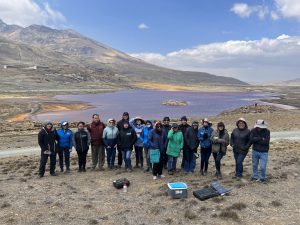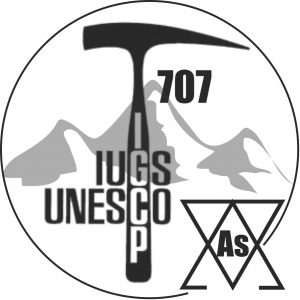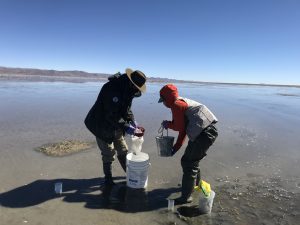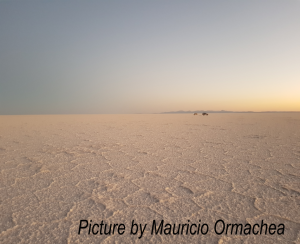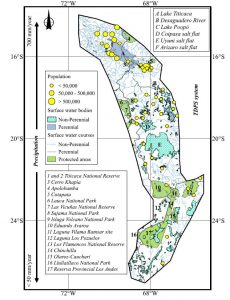Learn about arsenic in the environment with our webinar series! Follow the link: IGCP-707 WEBINARS
IGCP-707: Origin, distribution, and biogeochemistry of Arsenic in the Altiplano-Puna plateau of South America
This is a project funded by the IGCP-UNESCO (2020-2024)
Using an interdisciplinary approach, this international collaborative research investigates specific sites within the Altiplano-Puna plateau of Argentina, Bolivia, and Chile to better understand (i) the origin of arsenic, (ii) its geochemistry and mobility, (iii) its distribution in the environment, and (iv) its effects in the local community and unusual biodiversity.
According to the World Health Organization, approximately 140 million people from 50 countries are exposed to drinking water containing arsenic levels higher than the recommended limit (> 10 μg/L). In South America, the second highest plateau on Earth referred to as the “Altiplano-Puna”, which encompasses areas of Argentina, Bolivia, Chile, and Perú, exhibits high As concentrations in water that could be affecting 3 million inhabitants.
Human health, the environment, as well as scientific insight will benefit from this research. Moreover, the results and interpretations of this research will have substantial applicability to other regions of the world that experience elevated aqueous arsenic concentrations.
UNESCO Link IGCP-UNESCO-project 707
IGCP-707: Origen, distribución y biogeoquímica del Arsénico en el Altiplano-Puna de Sudamérica.
Este es un proyecto financiado por la IGCP-UNESCO entre 2020 -2024
Utilizando un enfoque interdisciplinario y cooperación internacional, se investigan sitios específicos en Altiplano-Puna para comprender (i) el origen del arsénico, (ii) su geoquímica y movilidad, (iii) su distribución en el medio ambiente y (iv) sus efectos en la comunidad local e inusual biodiversidad.
Según la Organización Mundial de la Salud, aproximadamente 140 millones de personas de 50 países están expuestas al consumo de agua con niveles de arsénico superiores al límite recomendado (> 10 μg/L). En América del Sur, la región del "Altiplano-Puna", que es el segundo plateau más alto del planeta abarcando territorios de Argentina, Bolivia, Chile y Perú, presenta concentraciones de arsénico elevados que podrían estar afectando a 3 millones de habitantes.
La salud humana, el medio ambiente, así como el conocimiento científico se beneficiarán de esta investigación. Los resultados e interpretaciones de este proyecto tendrán una aplicabilidad sustancial a otras regiones del mundo que experimentan concentraciones elevadas de arsénico.
Link de UNESCO IGCP-UNESCO-proyecto 707
Información del proyecto / Project information
Los principales objetivos del proyecto IGCP-UNESCO 707 están enfocados al estudio del arsénico (As) en el Altiplano-Puna para una mejor comprensión de los siguentes aspectos:
I- Origen del As
II- Geoquímica y movilidad del As
III- Distribución espacial y temporal de As
IV- Ciclo del As en lagunas y salares
V- Influencia del As en la salud humana
VI- Remediación de As
The main objectives of the IGCP-UNESCO 707 project are focused on arsenic (As) research in the Altiplano-Puna region to better understand the following aspects:
I- Origin of arsenic (As)
II- Geochemistry and mobility of As
III- Spatial and temporal distribution of As
IV- Cycling of As in saline lakes and salt flats
V- As influence on human health
VI- As remediation and capacity building
In Argentina:
- Laguna de los Pozuelos (12).
- Sitios Termales: Cerro Blanco, Aguas Calientes de Pastos Grandes, Incachule, Pompeya, Antuco, Cerro Galán, Tocomar (17)
In Bolivia:
- Reserva Nacional de Fauna Andina Eduardo Avaroa (10)
- Parque Nacional Sajama (8)
- Lago Poopo (C)
In Chile:
- Parque Nacional Lauca (6)
- Reserva Nacional Las Vicuñas (7)
- Parque Nacional Volcán Isluga (9)
- Parque Nacional Llullaillaco (16)
Murray, J. Guzmán, S., Tapia, J. Nordstrom, D.K. 2023. Silicic volcanic rocks, a main regional source of geogenic arsenic in waters: insights from the Altiplano-Puna plateau, Central Andes. Chemical Geology, 629, 121473 https://doi.org/10.1016/j.chemgeo.2023.121473
Tapia, J.; Mukherjee, A., Rodríguez, M. P., Murray, J.; Bhattacharya, P. 2022. Role of tectonics and climate on elevated arsenic in fluvial systems: Insights from surface water and sediments along regional transects of Chile. Environmental Pollution, 314, 120151. https://doi.org/10.1016/j.envpol.2022.120151
Tapia, J., Murray, J., Ormachea-Muñoz, M., & Bhattacharya, P. 2022. The Unique Altiplano-Puna Plateau: Environmental Perspectives. Journal of South American Earth Sciences, 115, 103725. https://doi.org/10.1016/j.jsames.2022.103725
Tapia J., Audry S. Murray J, Bhattacharya P, Ormachea-Muñoz M., Quino-Lima I., Nordstrom D.K. 2022. The solid-state partitioning, distribution, and mineralogical associations of arsenic and antimony: Integrated findings from the Altiplano Puna, South America and international comparisons. Journal of South American Earth Sciences, 114, 103713. https://doi.org/10.1016/j.jsames.2022.103713
Plaza-Cazón, J.; Benítez, L.; Murray, J.; Kirschbaum, P.; Donati, E. 2021. Influence of Extremophiles on the Generation of Acid Mine Drainage at the Abandoned Pan de Azúcar Mine (Argentina). Microorganisms 9, 281. https://doi.org/10.3390/microorganisms9020281
Tapia, J., Schneider, B., Inostroza, M., Álvarez-Amado, F., Luque, J.A., Aguilera, F., Parra, S., Bravo., M. 2021. Naturally elevated arsenic in the Altiplano-Puna, Chile and the link to recent (Mio-Pliocene to Quaternary) volcanic activity, high crustal thicknesses, and geological structures, Journal of South American Earth Sciences 105, 102905, https://doi.org/10.1016/j.jsames.2020.102905
Murray J., Nordstrom D.K., Dold B., Kirschbaum A. 2021. Seasonal fluctuations and geochemical modeling of acid mine drainage in the semi-arid Puna region: the Pan de Azúcar Pb-Ag-Zn mine, Argentina. Journal of South American Earth Sciences. 103197. https://doi.org/10.1016/j.jsames.2021.103197
Escalera R., Ormachea O., Ormachea M., García J.L., Suso J., García M.E., Hornero J., Fernandez O., Zelaya A., Huallpara L. 2020. Diseño e implementación de un sistema de tratamiento para la remoción de arsénico del agua de consumo en el altiplano y los valles de Bolivia , Revista Investigación & Desarrollo 20(1):23-39. http://dx.doi.org/10.23881/idupbo.020.1-2i
Lima I. Q., Ramos Ramos O. E., Ormachea Muñoz M., Chambi Tapia M. I., Quintanilla Aguirre J., Ahmad A., Prakash Maity J., Islam Md. T.l, Bhattacharya P. 2020. Geochemical mechanisms of natural arsenic mobility in the hydrogeologic system of Lower Katari Basin, Bolivian Altiplano, Journal of Hydrology, 125778, https://doi.org/10.1016/j.jhydrol.2020.125778 .
Lima I. Q., Ormachea Muñoz M., Ramos Ramos O. E., Quintanilla Aguirre J., Prakash Maity J., Ahmad A., Bhattacharya P. 2020. Hydrogeochemical contrasts in the shallow aquifer systems of the Lower Katari Basin and Southern Poopó Basin, Bolivian Altiplano, Journal of South American Earth Sciences, 102914, https://doi.org/10.1016/j.jsames.2020.102914
Tapia, J., Audry, S., van Beek, P. 2020. Natural and anthropogenic controls on particulate metal(loid) deposition in Bolivian highland sediments, Lake Uru Uru (Bolivia). The Holocene, 30(3):428-440, https://doi.org/10.1177%2F0959683619887425
De Loma, J., Tirado, N., Ascui, F., Levi,M., Vahter,M., Broberg,M., Gardon, J., 2019. Elevated arsenic exposure and efficient arsenic metabolism in indigenous women around Lake Poopó,Bolivia. Sci. Total Environ. 657, 179–186. https://doi.org/10.1016/j.scitotenv.2018.11.473 .
Murray, J., Nordstrom, D. K., Dold, B., Romero Orué, M., & Kirschbaum, A. 2019. Origin and geochemistry of arsenic in surface and groundwater of Los Pozuelos Basin, Puna region Argentina. Science of the Total Environment, 697, 134085, https://doi.org/10.1016/j.scitotenv.2019.134085
Tapia, J., Murray, J., Ormachea, M., Tirado, N., Nordstrom, D., K., 2019. Origin, distribution, and geochemistry of arsenic in the Altiplano-Puna plateau of Argentina, Bolivia, Chile, and Perú. Sci. Total Environ. 678, 309–325. https://doi.org/10.1016/j.scitotenv.2019.04.084
Dra. Agostina Chiodi, Argentina (CONICET – Universidad Nacional de Salta)
Dra. Silvina Guzmán, Argentina (CONICET – Universidad Nacional de Salta)
Dr. Daniel Martinez, Argentina (CONICET – Universidad Nacional de Mar del Plata)
Dr. Blaine McCleskey, United States (USGS-Boulder-Colorado)
Dr. Bernhard Dold, Chile (Sustainable Mining Research & Consultancy (SUMIRCO))
M. E. García, Bolivia (IIQ, Universidad Mayor de San Andrés)
Sc. Lizangela Huallpara, Bolivia (IIQ, Universidad Mayor de San Andrés)
Ktlyn Aguirre De la Quintana, Universidad Mayor de San Andrés, Bolivia
Nicole Jimeno Ruiz, Bolivia, Universidad Mayor de San Andrés, Bolivia
Josue Mamaní, Universidad Mayor de San Andrés, Bolivia
Manuel Inostroza Pizarro, Universidad Católica del Norte, Chile
Bianca Sepúlveda, Universidad Santo Tomás, Chile
Edgar Emanuel Legizamón, Universidad Nacional de Salta, Argentina
Carla Andrea Martínez, Universidad Nacional de Salta, Argentina
Fundación Humedales, Argentina
Monumento Natural Laguna de Los Pozuelos, Administración de Parques Nacionales, Argentina
